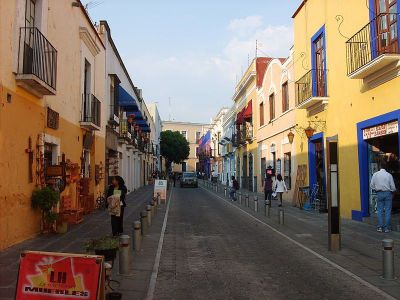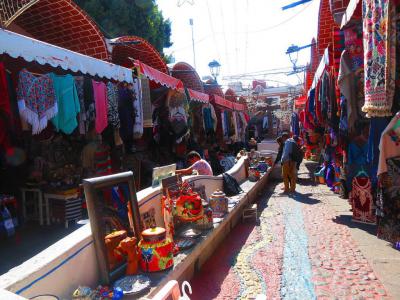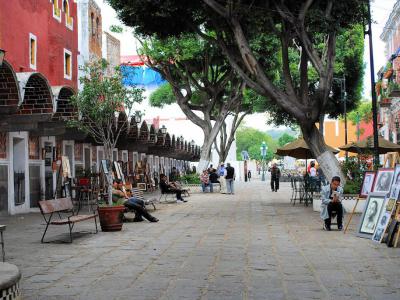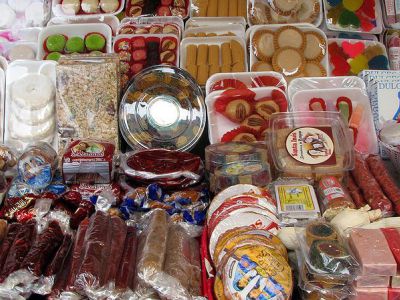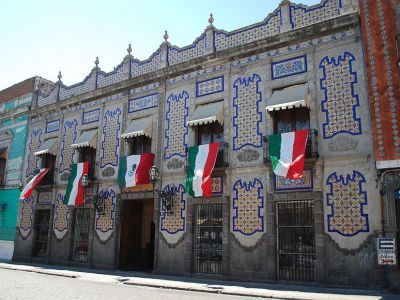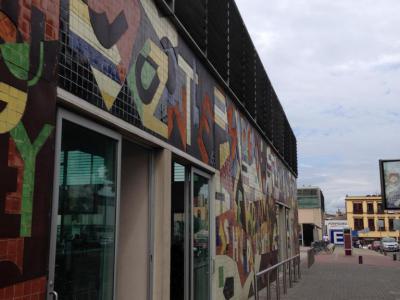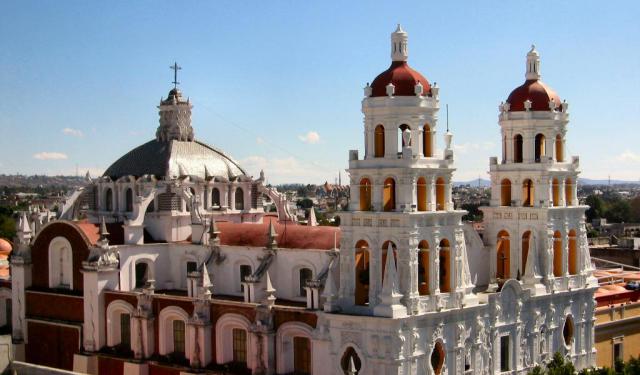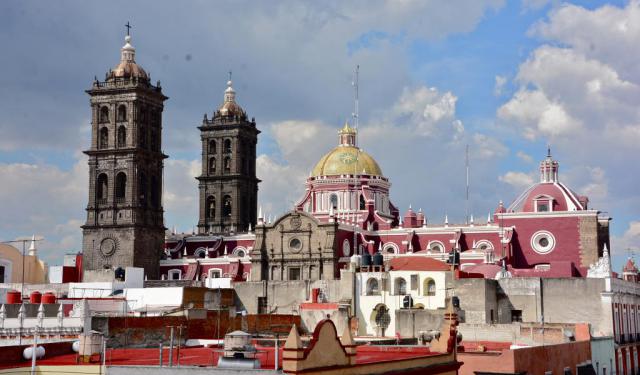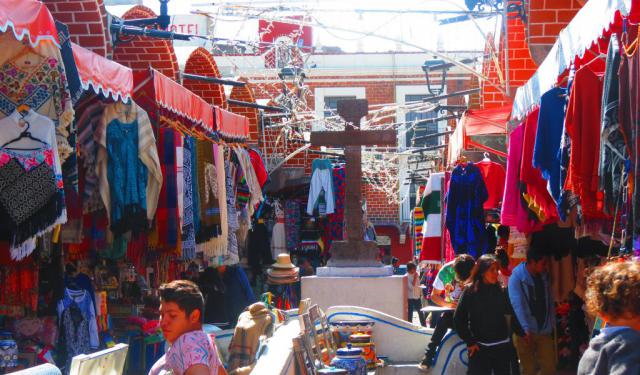
Puebla Food Tasting and Shopping Tour (Self Guided), Puebla
Among other delights that the Mexican city of Puebla can pride itself on is the abundant food and shopping scene fit to delight even the most discerning travelers with an array of colors and flavors to treat themselves to.
One spot to visit for non-trivial shopping is the Alley of the Frogs (Callejón de los Sapos), where antique stores and vendors line the cobblestone streets, offering a treasure trove of unique finds.
For artisanal crafts, the Parian Crafts Market is a must. Here, you can explore a variety of handcrafted goods, from Talavera pottery to textiles, showcasing the talent of local artisans.
In the Artist Quarter (Barrio del Artistas), visitors can immerse themselves in the creative atmosphere, browsing galleries and boutiques filled with paintings, sculptures, and other artworks. Meanwhile, Calle de los Dulces, or Sweets Street, is a haven for those with a sweet tooth, offering a plethora of traditional Mexican sweets and treats to indulge in.
For a deeper dive into Puebla's rich artistic heritage, a visit to the Uriarte Talavera Workshop is essential. The place gives the chance to witness the intricate process of making Talavera pottery (a UNESCO Intangible Cultural Heritage) and even purchase authentic pieces to take home.
Food enthusiasts will delight in the culinary offerings of Puebla, with places like Mercado Venustiano Carranza, known for its delicious cemitas, a type of sandwich unique to the region. At the same time, the Market of Poblano Flavors tantalizes taste buds with a wide array of traditional Poblano dishes, showcasing the diverse flavors of the region.
Whether you're seeking unique souvenirs, delectable treats, or immersive cultural experiences, Puebla offers something for everyone. So, venture into its streets, savor its flavors, and discover the richness of this enchanting city for yourself. Your journey through Puebla promises to be a memorable one, filled with delights for all the senses!
One spot to visit for non-trivial shopping is the Alley of the Frogs (Callejón de los Sapos), where antique stores and vendors line the cobblestone streets, offering a treasure trove of unique finds.
For artisanal crafts, the Parian Crafts Market is a must. Here, you can explore a variety of handcrafted goods, from Talavera pottery to textiles, showcasing the talent of local artisans.
In the Artist Quarter (Barrio del Artistas), visitors can immerse themselves in the creative atmosphere, browsing galleries and boutiques filled with paintings, sculptures, and other artworks. Meanwhile, Calle de los Dulces, or Sweets Street, is a haven for those with a sweet tooth, offering a plethora of traditional Mexican sweets and treats to indulge in.
For a deeper dive into Puebla's rich artistic heritage, a visit to the Uriarte Talavera Workshop is essential. The place gives the chance to witness the intricate process of making Talavera pottery (a UNESCO Intangible Cultural Heritage) and even purchase authentic pieces to take home.
Food enthusiasts will delight in the culinary offerings of Puebla, with places like Mercado Venustiano Carranza, known for its delicious cemitas, a type of sandwich unique to the region. At the same time, the Market of Poblano Flavors tantalizes taste buds with a wide array of traditional Poblano dishes, showcasing the diverse flavors of the region.
Whether you're seeking unique souvenirs, delectable treats, or immersive cultural experiences, Puebla offers something for everyone. So, venture into its streets, savor its flavors, and discover the richness of this enchanting city for yourself. Your journey through Puebla promises to be a memorable one, filled with delights for all the senses!
How it works: Download the app "GPSmyCity: Walks in 1K+ Cities" from Apple App Store or Google Play Store to your mobile phone or tablet. The app turns your mobile device into a personal tour guide and its built-in GPS navigation functions guide you from one tour stop to next. The app works offline, so no data plan is needed when traveling abroad.
Puebla Food Tasting and Shopping Tour Map
Guide Name: Puebla Food Tasting and Shopping Tour
Guide Location: Mexico » Puebla (See other walking tours in Puebla)
Guide Type: Self-guided Walking Tour (Sightseeing)
# of Attractions: 7
Tour Duration: 1 Hour(s)
Travel Distance: 2.5 Km or 1.6 Miles
Author: HelenF
Sight(s) Featured in This Guide:
Guide Location: Mexico » Puebla (See other walking tours in Puebla)
Guide Type: Self-guided Walking Tour (Sightseeing)
# of Attractions: 7
Tour Duration: 1 Hour(s)
Travel Distance: 2.5 Km or 1.6 Miles
Author: HelenF
Sight(s) Featured in This Guide:
- Callejón de los Sapos (Alley of the Frogs)
- Mercado de Artesanias "El Parián" (Parian Crafts Market)
- Barrio del Artistas (Artist Quarter)
- Calle de los Dulce (Sweets Street)
- Uriarte Talavera Workshop
- Mercado Venustiano Carranza (Cemitas Market)
- Mercado de Sabores Poblanos (Market of Poblano Flavors)
1) Callejón de los Sapos (Alley of the Frogs) (must see)
The Alley of the Frogs (Callejon de los Sapos) is a popular street and square in the historic center of Puebla city and an ideal place for collectors and art lovers. It is the location of many stores housed in historic buildings. Most of these stores sell antiques ranging from furniture to books.
Along with the antique shops, the street offers outdoor entertainment on weekends. Musicians play open-air on Saturdays and Sundays while vendors sell handicrafts from outdoor booths. There are also several restaurants and cantinas for those who prefer drinking and dining.
The name of the street is believed to have come from the colonial period of Puebla. The story is that the alley was often flooded with stagnant water. It attracted a large number of toads, which caused locals to refer to it as Toad Alley.
The buildings themselves offer a marvel for the walking tour. They are designed with traditional colonial architecture and painted in bright blues, pinks, and yellows. A beautiful fountain in the middle of the square, along with a toad sculpture is a constant reminder of old times.
The Alley of the Frogs was built in 1849. A bullring was held in the plaza until it was demolished in 1867. Bullfighting gave way to shops and a weekend flea market that still exists today. Shoppers will find paintings, statuettes, postcards, collectible coins, and old records among the treasures.
The stores at the Alley of the Frogs are open daily from 9 AM to 5 PM. However, the square is available for visitors to enjoy 24 hours a day.
Along with the antique shops, the street offers outdoor entertainment on weekends. Musicians play open-air on Saturdays and Sundays while vendors sell handicrafts from outdoor booths. There are also several restaurants and cantinas for those who prefer drinking and dining.
The name of the street is believed to have come from the colonial period of Puebla. The story is that the alley was often flooded with stagnant water. It attracted a large number of toads, which caused locals to refer to it as Toad Alley.
The buildings themselves offer a marvel for the walking tour. They are designed with traditional colonial architecture and painted in bright blues, pinks, and yellows. A beautiful fountain in the middle of the square, along with a toad sculpture is a constant reminder of old times.
The Alley of the Frogs was built in 1849. A bullring was held in the plaza until it was demolished in 1867. Bullfighting gave way to shops and a weekend flea market that still exists today. Shoppers will find paintings, statuettes, postcards, collectible coins, and old records among the treasures.
The stores at the Alley of the Frogs are open daily from 9 AM to 5 PM. However, the square is available for visitors to enjoy 24 hours a day.
2) Mercado de Artesanias "El Parián" (Parian Crafts Market)
Parian Crafts Market, or El Parian, is a crafts market in Puebla. It is the only traditional handcraft market in the city and one of the most-frequented tourist attractions.
El Parian first opened in 1760. It operated until the end of the 19th century. Most of the buildings of El Parian use traditional Puebla architecture, made of brick with Talavera tile accents ( a type of majolica pottery, distinguished by a milky-white glaze.)
The advent of the railroad caused the market to falter. El Parian turned into a flea market for over 100 years until it was revamped into the handicrafts market seen today. It has been in steady operation as a handcrafts market since 1961.
El Parian offers more than 100 stores and services. Handcrafts from around Mexico are available to peruse and buy. The typical offerings are pottery, clothing, leather, wood items, jewelry, silver, traditional candies, and Talavera pottery.
The market is open daily from 10 AM to 7:30 PM.
El Parian first opened in 1760. It operated until the end of the 19th century. Most of the buildings of El Parian use traditional Puebla architecture, made of brick with Talavera tile accents ( a type of majolica pottery, distinguished by a milky-white glaze.)
The advent of the railroad caused the market to falter. El Parian turned into a flea market for over 100 years until it was revamped into the handicrafts market seen today. It has been in steady operation as a handcrafts market since 1961.
El Parian offers more than 100 stores and services. Handcrafts from around Mexico are available to peruse and buy. The typical offerings are pottery, clothing, leather, wood items, jewelry, silver, traditional candies, and Talavera pottery.
The market is open daily from 10 AM to 7:30 PM.
3) Barrio del Artistas (Artist Quarter)
The Artist Quarter (Barrio del Artistas) is an iconic artists' zone of Puebla with numerous spaces for artists to work and exhibit. Most of the members of the Artist Quarter are painters, but there are also sculptors and at least one musician.
There are more than 45 workshops in the neighborhood that allow visitors to watch as artists learn and practice their crafts. There are exhibitions of these works of art every 15 days. The artists' union also mounts exhibits that travel throughout Mexico each year.
The neighborhood emerged in 1941. It was founded by brothers artists Jose and Angel Marquez Figueroa, both teachers at the Academy of Fine Arts in Puebla. They approached the governor, Gonzalo Bautista Castillo, with the plan of creating an area for artists to practice their trade. The governor granted them a location for an artists' collective, the Union of Plastic Arts of Puebla.
Today the Artist Quarter is a popular area with cafés and studios and a brightly colored colonial square. The visitors can relax on a bench and admire the artistic treasures to be found all around this bohemian and dynamic zone.
There are more than 45 workshops in the neighborhood that allow visitors to watch as artists learn and practice their crafts. There are exhibitions of these works of art every 15 days. The artists' union also mounts exhibits that travel throughout Mexico each year.
The neighborhood emerged in 1941. It was founded by brothers artists Jose and Angel Marquez Figueroa, both teachers at the Academy of Fine Arts in Puebla. They approached the governor, Gonzalo Bautista Castillo, with the plan of creating an area for artists to practice their trade. The governor granted them a location for an artists' collective, the Union of Plastic Arts of Puebla.
Today the Artist Quarter is a popular area with cafés and studios and a brightly colored colonial square. The visitors can relax on a bench and admire the artistic treasures to be found all around this bohemian and dynamic zone.
4) Calle de los Dulce (Sweets Street)
Sweet Street (Calle de los Dulces) is a street in the center of Puebla, lined with stores selling sweets. Tourists will see candy shops, bakeries, cookie stores, and gift baskets. There are approximately 40 of these stores that sell items as varied as sweet potatoes (camotes) and crystallized peaches.
Sweets Street occupies about three blocks of 6 East Avenue near St. Domingo Convent, Victory Market, and the Main Theatre of Puebla. Along with sweets, shoppers will find boutiques that sell jewelry, handbags, sporting goods, and handicrafts. The street is an excellent place to find souvenirs, local foods, and a variety of delicious.
The sweets shops are primarily owned by families who have had the stores and the recipes passed down for generations. Many shop owners live above their stores just as their ancestors did before them. The oldest of the shops is the Great Fame (La Gran Fama), which opened in 1892.
Most of the stores on Sweet Street open around 10 AM. Closing hours vary from store to store.
Sweets Street occupies about three blocks of 6 East Avenue near St. Domingo Convent, Victory Market, and the Main Theatre of Puebla. Along with sweets, shoppers will find boutiques that sell jewelry, handbags, sporting goods, and handicrafts. The street is an excellent place to find souvenirs, local foods, and a variety of delicious.
The sweets shops are primarily owned by families who have had the stores and the recipes passed down for generations. Many shop owners live above their stores just as their ancestors did before them. The oldest of the shops is the Great Fame (La Gran Fama), which opened in 1892.
Most of the stores on Sweet Street open around 10 AM. Closing hours vary from store to store.
5) Uriarte Talavera Workshop
You just cannot leave Puebla without visiting Uriarte Talavera workshop, because it is the only place in the city where you can witness the elaborate process of making talaveras. At Uriarte there are exquisite decorative items for sale, such as astrays, urns, pots, platters and many other talaveras. Come, admire and pick your own talavera.
6) Mercado Venustiano Carranza (Cemitas Market)
Mercado Venustiano Carranza is also known as the Cemitas Market. It is a special food market, where you can purchase fresh fruit and vegetables. You will also get acquainted with the culinary delights of Mexico. There is no other place in the world that makes cemitas better than in Puebla.
7) Mercado de Sabores Poblanos (Market of Poblano Flavors)
The Market of Poblano Flavors (Mercado de Sabores Pablons) is a market that promotes and sells cuisine from the Puebla region. It was opened in 2011 by the mayor of Puebla Blanca Alcala.
The market offers more than 130 spaces that sell traditional Poblano foods and sweets. Fourteen franchisees sell foods such as quesadillas, tamales, and carnitas.
The Market of Poblano Flavors is popular with both tourists and locals. Prepared meals and drinks are available along with a dining area with open seating.
While food is the primary focus of the Market of Poblano Flavors, some vendors sell handcrafts and souvenirs. Visitors will also enjoy open-air art displays by artist Luz Elvira Torres and a mosaic mural by Jose Lazcarro that decorates the building.
The market is open daily from 9 AM to 7 PM.
The market offers more than 130 spaces that sell traditional Poblano foods and sweets. Fourteen franchisees sell foods such as quesadillas, tamales, and carnitas.
The Market of Poblano Flavors is popular with both tourists and locals. Prepared meals and drinks are available along with a dining area with open seating.
While food is the primary focus of the Market of Poblano Flavors, some vendors sell handcrafts and souvenirs. Visitors will also enjoy open-air art displays by artist Luz Elvira Torres and a mosaic mural by Jose Lazcarro that decorates the building.
The market is open daily from 9 AM to 7 PM.
Walking Tours in Puebla, Mexico
Create Your Own Walk in Puebla
Creating your own self-guided walk in Puebla is easy and fun. Choose the city attractions that you want to see and a walk route map will be created just for you. You can even set your hotel as the start point of the walk.
Puebla Colonial Architecture Walking Tour
One of the most authentic and traditional destinations in Mexico, the city of Puebla abounds in Baroque architecture, or rather the peculiar regional form thereof resulted from the fusion of European and indigenous styles in the 17th and 18th centuries.
Visiting this magical place you will find lots of (more than 70!) sumptuous churches, convents and sanctuaries, as well as other incredible... view more
Tour Duration: 2 Hour(s)
Travel Distance: 3.0 Km or 1.9 Miles
Visiting this magical place you will find lots of (more than 70!) sumptuous churches, convents and sanctuaries, as well as other incredible... view more
Tour Duration: 2 Hour(s)
Travel Distance: 3.0 Km or 1.9 Miles
Puebla Introduction Walking Tour
The city of Puebla is the capital of the state of Puebla and the fourth largest city in Mexico. It was founded in 1531 in an uninhabited area between two indigenous settlements of the time, Tlaxcala and Cholula. The area used to be called Cuetlaxcoapan, which means "where serpents change their skin".
Spanish conquistador Hernán Cortés occupied the Puebla region in 1519, killing most... view more
Tour Duration: 2 Hour(s)
Travel Distance: 2.5 Km or 1.6 Miles
Spanish conquistador Hernán Cortés occupied the Puebla region in 1519, killing most... view more
Tour Duration: 2 Hour(s)
Travel Distance: 2.5 Km or 1.6 Miles
The Most Popular Cities
/ view all
